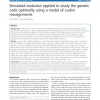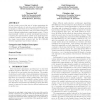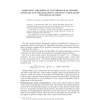324 search results - page 18 / 65 » Measuring the Dynamics of Artificial Evolution |
BMCBI
2011
13 years 2 months ago
2011
Background: As the canonical code is not universal, different theories about its origin and organization have appeared. The optimization or level of adaptation of the canonical ge...
FOGA
2011
12 years 11 months ago
2011
It was recently proven that sets of points maximizing the hypervolume indicator do not give a good multiplicative approximation of the Pareto front. We introduce a new “logarith...
CORR
2010
Springer
13 years 7 months ago
2010
Springer
A pseudorandom point in an ergodic dynamical system over a computable metric space is a point which is computable but its dynamics has the same statistical behavior of a typical po...
GECCO
2009
Springer
14 years 2 months ago
2009
Springer
A number of representation schemes have been presented for use within Learning Classifier Systems, ranging from binary encodings to neural networks. This paper presents results fr...
AI50
2006
13 years 11 months ago
2006
This case study demonstrates how the synthesis and the analysis of minimal recurrent neural robot control provide insights into the exploration of embodiment. By using structural e...



